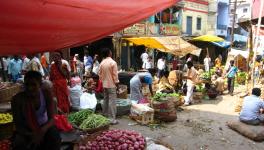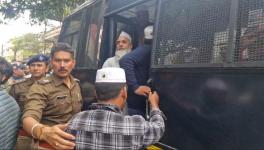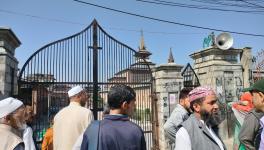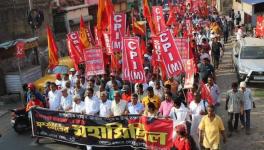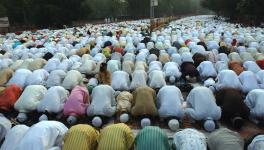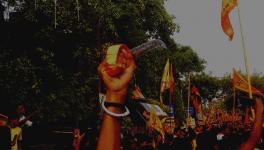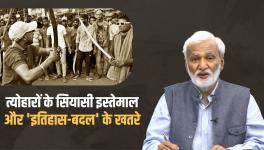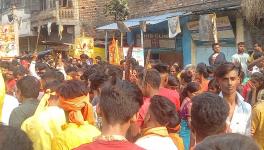Ram Navami Violence: How Bihar Sharif Saw the Communal Flare-up
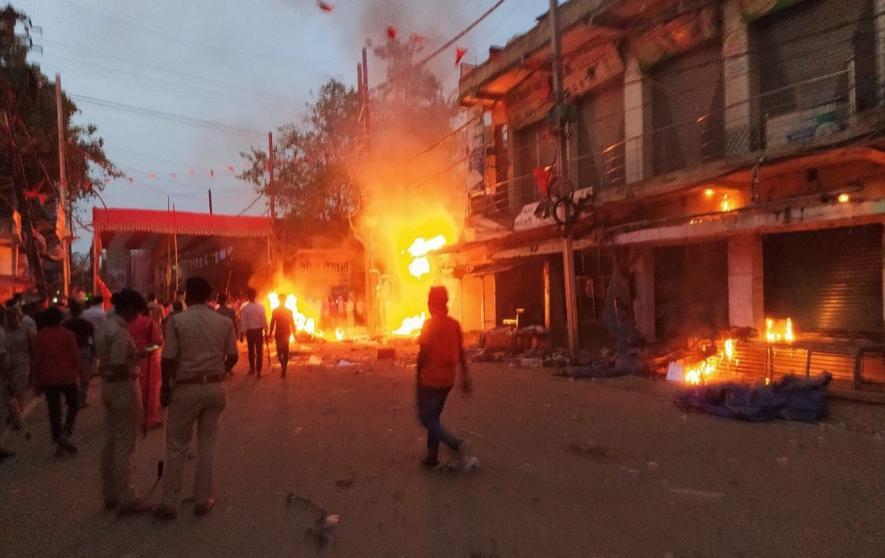
Nawada (Bihar)/New Delhi: Charred remains of vehicles; burned shops and buildings dotting the landscape; looted showrooms; bricks, stones and glass shards strewn on hotel beds — the signs of communal violence that rocked the ancient town of Bihar Sharif in Nawada district of Bihar on March 31 still look fresh.
That day, the hustle and bustle of the historic town was at its peak with the festive spirit of Ramzan and Ram Navami (celebration of lord Rama’s birth). Little did the people know that the peaceful atmosphere would soon be engulfed by the fire of communal violence. The violence, which lasted for hours, apparently without any police intervention, has shaken the very core of the city — leaving behind a trail of destruction.
According to multiple people NewsClick spoke with, the Bajrang Dal (a Hindu nationalist militant organisation) had been granted permission by the district administration to organise a Shobha Yatra or procession on Friday March 31 — a day after Ram Navami.
Announcements were allegedly made, urging Hindus not to open their shops on Friday. This claim, however, could not be verified as the police neither denied nor accepted it — saying their investigations were on.
Beyond anyone’s expectations, including the law enforcement agencies, about 50,000 people — according to District Magistrate Shashank Shubhankar’s own admission — attended the processions. However, a crowd of a maximum of 5,000 people were allowed to participate in the rally.
“The idea was to outnumber the police force,” he told NewsClick.
Though there was complete ban on disk jockey (DJ) loudspeaker systems and brandishing of weapons, such as swords, huge sound amplifiers on big trucks were playing communally charged and provocative songs and slogans, said several people NewsClick spoke with.
The procession started at around 2 p.m from Shram Kalyan Maidan and had to end at Baba Maniram Akhada temple, passing through Hospital Mod, Bharao Par, Kanta Par, Gagan Diwan, Soghra College Mod — a stretch of around 4.5 km along the Main Road (also called Ranchi Road).
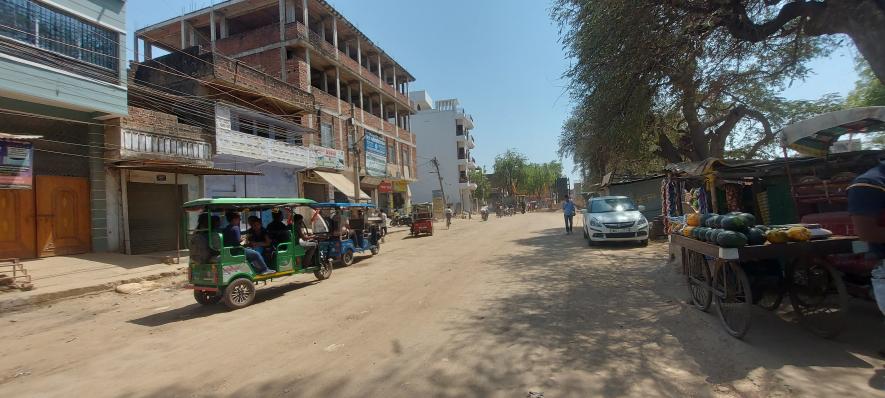
As the procession was passing in front of a mosque on the main road at Murarpur, the flavour of DJs playing religious songs and bhajans changed, said some eyewitnesses.
“The songs were no longer religious. Lord Rama suddenly turned a threat or symbol of a promised land. The lyrics of most of the songs are similar — assertions that the Ram temple will be built, that Muslims will be shown their place, that they too will be forced to chant Rama’s name. ‘Kill them or send them to Pakistan’, goes one song, ‘but don’t let them fatten on the nation’s resources’,” said Anil Rai, a resident of the area.
Such songs have become popular in the past few years, such as “topi wala bhi sar jhuka kar, Jai Shri Ram bolega” (one wearing a skull cap will also be forced to chant Jai Shri Ram). Many of these songs are indigenous compositions. Technology and the internet are making them easier to put together as albums.
If allegations by some local residents are something to go by, this time, the slogans were highly “provocative”, “abusive” and “objectionable”.
Derogatory slogans that stereotype the appearance of Muslim men, asking them to “Go to Pakistan”, “The graves of Babar's children will be dug in India only” and “Pakistan-supported Muslims, your end is certain now” rented the air.
The district magistrate, too, agreed that the songs and slogans were objectionable and provocative, but stressed that the CDs and pen-drives the police seized did not have such slogans cited above.
“DJs were banned, but could not have been forcefully removed as that would have led to further worsening of the situation. Later, we took swift action and arrested the organiser and the man who had rented out the music system,” he said, adding “there were deliberate attempts to ridicule a particular community. Not just the songs or slogans, but the tone and the demeanour of the participants of the rally were aggressive”.
The procession progressed on the permitted route. Eyewitnesses said there were heated exchange when the DJs, playing the songs and slogans loudly, were made to halt right in front of Shahi Masjid (mosque) at Murarpur in Bharao Par area. The two sides were pacified and the procession moved ahead.
Then, a few “rowdy” young men in the crowd stopped two men near Muslim-concentrated Gagan Diwan locality — nearly half a kilometre from Murarpur on the same stretch — and allegedly asked them to chant ‘Jai Shri Ram’ (a Hindu religious slogan).
“The elderly person among the two men chose not to react, but the younger one, who was in his early 20s. objected. He was brutally thrashed. This triggered an altercation. A saffron flag was hoisted in a graveyard, which is located at Gagan Diwan along the Ranchi Road. That was when the situation slipped out of hand,” said Jamil Akhtar, ex-municipal councillor of Ward No. 39, who lives in the locality.
However, DM Shubhankar said it was not that the other community (Muslims) did not react. “The youth, majority of whom were in their early 20s, were out of control. As the brawl started (after the two men were asked to chant Jai Shri Ram), Muslims also indulged in stone-pelting. But its retaliation was highly disproportionate, organised and lethal,” he said.
This triggered a stampede-like situation, and a portion of the rally returned back to run amok. The rioters torched two buses parked in a garage (City Complex) owned by one Murtaza Ansari. What suggests a targeted attack was the fact that close to it, there was another garage that was left untouched.
The burning of vehicles, shops and houses soon after the procession turned violent, points to the fact that the rioters were prepared and were carrying inflammables with them.
The district magistrate also accepted that the crowd was “prepared before-hand”, and was carrying “inflammables and explosives”.
Continuing the rioting and arson spree, the rioters reached Kanta Par where they set ablaze the City Palace — owned by Mohammad Sultan Ahmad Ansari, a leader of the ruling Janata Dal (United). The three-storeyed marriage hall was completely destroyed.
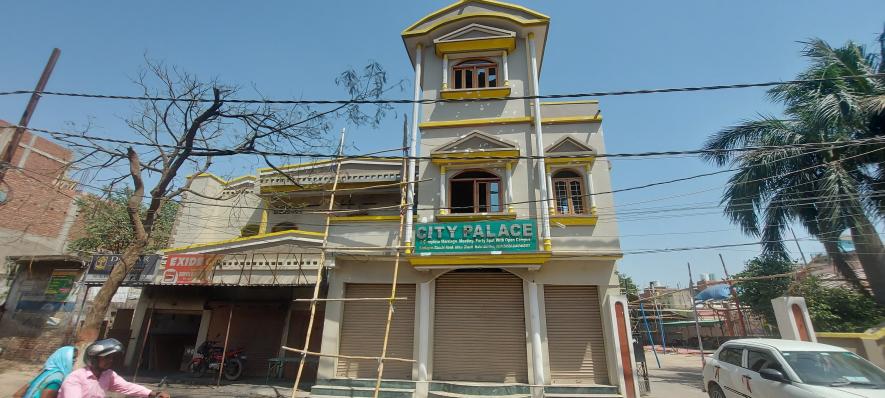
“The property was closed on March 31 in view of the Ram Navami Shobha Yatra, therefore, there was no employee here. It was around 5 p.m when the rioters hurled petrol bombs and set it on fire. We were at home, unaware of what was happening outside. We saw flames and smoke rising from the terrace only after our neighbours informed us about the incident,” said Mohammad Aslam, the manager of the property.
He said, along with the owner, he rushed to the hall but could not enter the premises as it was taken over by over 1,000 armed and masked rioters.
“At the same time, heavy stone pelting was being done on the road. They broke all CCTV cameras and took away the DVR. Our repeated phone calls to police officials went unanswered. Even the fire engines arrived at around 7 p.m. By the time it reached, nothing was left except ashes,” he said.
Incidentally, Lahedi police station is just a few metres away from the hotel.
When NewsClick visited the marriage hall, it was being repaired and painted. All the furniture and electrical fittings had turned into ashes. The fire was so strong that it had brought down plasters and caused cracks on the walls.
Asked why they were getting the repair work done even before examination of the site by a forensic team, Aslam said, “We have prior bookings from April 26 onward; and therefore, we were left with no option but to begin the repair works the very next day.”
Asked about the loss, he estimated it to be around Rs 50-60 lakh.
Opposite to City Palace, there are two other marriage halls — Sai Palace and Krishna Palace. But no losses were caused to these properties.
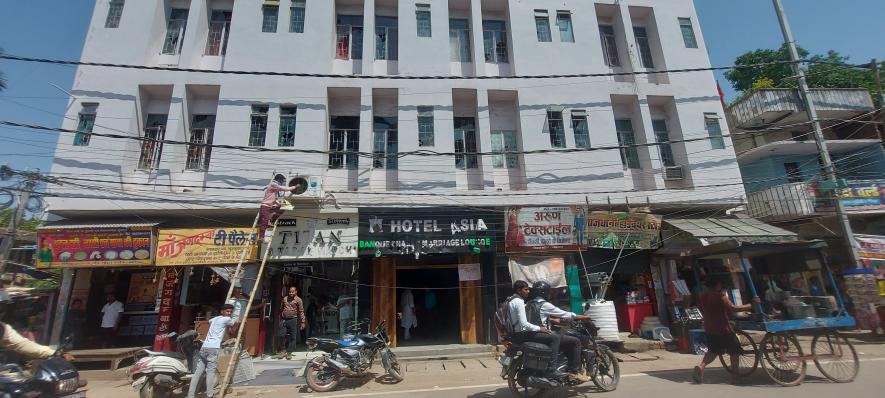
A few metres away from City Palace, there is another banquet and marriage hall — Hotel Asia — which was allegedly ransacked. It could not be burnt, as its main entrance was locked from inside and the rioters failed to break its grill channels, said some local redidents.
They managed to break a small gate on the rear side of the hotel where they found a generator and burnt it. After the generator caught fire and huge flames started rising, it was impossible for them to enter the property. But at the same time, it favoured them as well. The fire caused power outage that led the CCTV camera to stop recording the incident and the rioters.
Rupesh Kumar, a worker at the hotel, said it was around 3 p.m when the mob went on rampage.
“As I saw commotion all around and smoke rising from different buildings. I locked the main gate and bolted ourselves in a room on the ground floor. They broke two channels each on both ends of the grills, but could not come in from the narrow path. They tried to break in, but failed. Since they had already set the generator on fire, the rear entrance could not be used to enter,” he told NewsClick.
The dormitory on the first floor of the hotel was enough to narrate the horror that unfolded that fateful day. Bricks and glass shards were strewn on beds and the floor. The broken window panes stood testimony to intensity of the stone pelting.
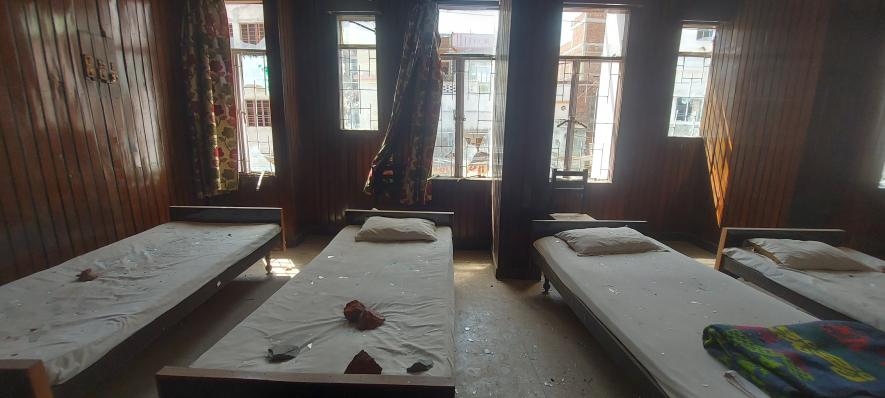
Sohail Anwar, caretaker of the hotel, said they had a recording of the arson from 5:30 pm to 6:15 pm. “We recognise most of the attackers as they were locals. Even some of those who used to sell vegetables on carts in front of this hotel were seen pelting stones and breaking the main gate,” he alleged.
The rioters continued to move ahead, hunting down Muslim shops, houses and religious places, it was alleged.
At around 5:30 p.m, a truck carrying a highly powerful DJ systems stopped in front of the Murarpur mosque.
“As it was announced that ‘ab ho gaya, chadh jao, bhago mat’ (it has begun; climb up; don’t run away), a crowd of around 500-1,000 people broke into the mosque’s main gate and entered its campus. A few of them climbed up and brought down two minarets. Four motorbikes and a three-wheelers parked in the campus were burnt. I had locked myself in a room for hours before being rescued by the police,” alleged the mosque’s imam (prayer leader), Mohammad Shahabuddin.
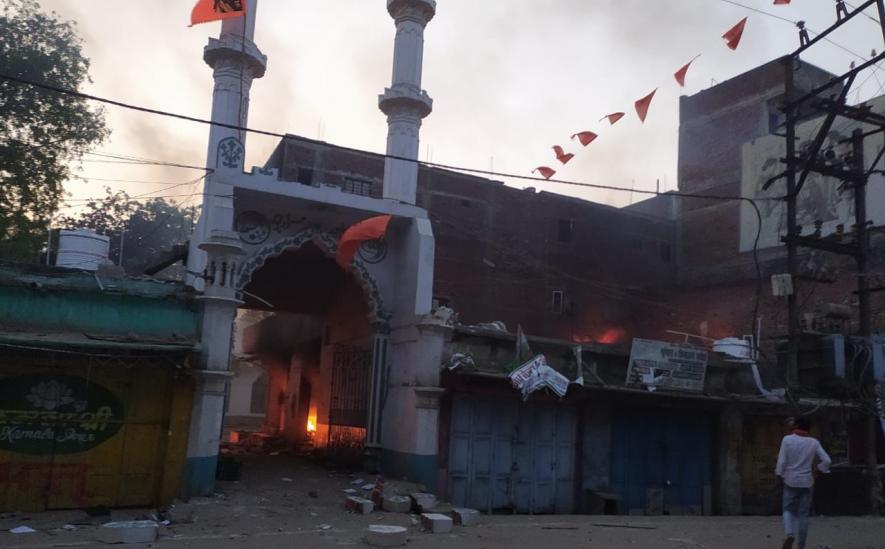
He said the violence continued for a good 40-45 minutes, but the police did not arrive till then. Instead of acting tough against the perpetrators and investing energy on nabbing them, he alleged that the cops were forcing the mosque’s managing committee to begin the repair work even without forensic examination and a work order.
“They (the police) have already forcefully got the two minarets constructed with the aim to remove the evidence,” he alleged.
Mohammad Naushad Alam had been selling fruits and dry fruits for the past 40 years at Bharao Chauraha (crossroad). His two shops were set on fire. His warehouse in the mosque complex was also destroyed by the fire.
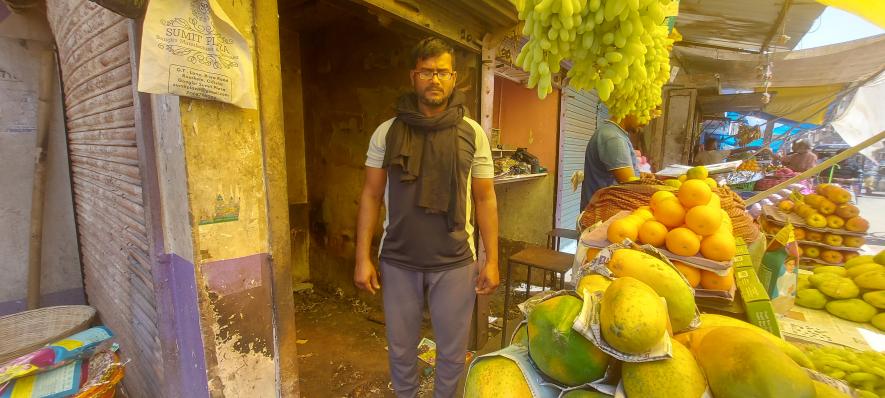
“They first looted my shops and warehouse and then set them on fire,” he said, claiming that the loss he incurred was over Rs 15 lakh.
His complaint has allegedly not been officially received by the police.
From Bharao Chowraha, the mob deviated from the permitted Shobha Yatra route (Ranchi Road) and went approximately 1 km in a completely different direction to “burn” the historic Madarsa Azizia in the Murarpur neighbourhood and Digital Duniya (a showroom of furniture and electronics and electrical appliances) at Nala Road, said some eyewitnesses.
Armed with petrol bombs, as narrated by eyewitnesses, a mob comprising about 1,000 people barged into the madrasa and set it on fire. Its library, which had around 5,000 books — including precious manuscripts and historical documents, was completely destroyed.
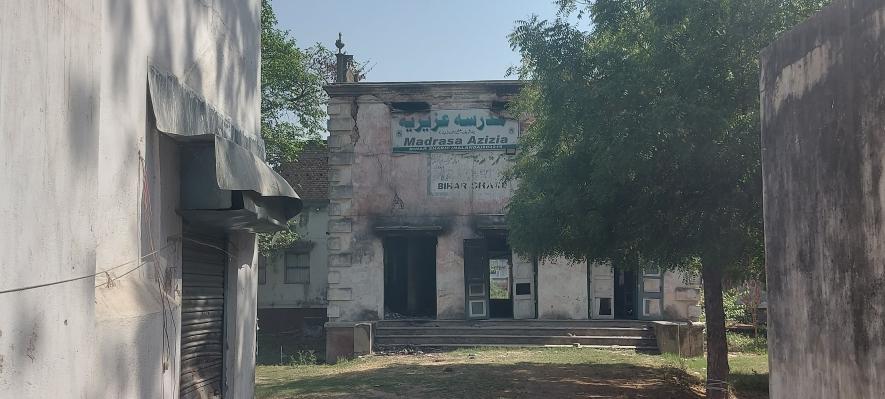
Seeing the mob entering the campus, the madrasa’s guard Mohan Bahadur tried to lock its gates, but the rioters pelted stones and threatened to kill him, he alleged, adding that he got got scared and fled the spot.
Mohammad Shakir Qasmi, the principal of the madrasa, said he was at home to break his Ramzan fast when the violence erupted. He reached the place after the guard informed him about the same over cell phone. But he could not do anything as the crowd was “big and extremely aggressive”.
Qasmi said the library had handwritten Islamic books dating to over 100 years. “All those books are now gone,” he added.
Sitting on a revolving chair in his now completely empty showroom, Jawed Azam, the owner of Digital Duniya, showed on his cell phone CCTV footage of the raid on his showroom by miscreants.
Breaking the shutter, a mob can be seen entering the showroom and looting it. Some of them can be seen picking up mobile phones, while others are seen grabbing television sets.
“Despite living in Mumbai, we invested and started businesses in Bihar to provide employment to locals. Seeing this type of incident, who will come to work in the state,” he told NewsClick, alleging that he got no help from any political party, the police and even the chief minister’s office in Patna, despite the fact that he belongs to a political family.
“I called Mangal Pandey, Shahnawaz Hussain, the state BJP chief, the chief minister’s office and the district administration, but got no help at all,” he added.
Azam owns eight electronics showrooms in Bihar with the same name, Digital Duniya.
His brother, Hyder Azam, is state secretary of the Bharatiya Janata Party (BJP) in Maharashtra. He has served Maulana Azad Minorities Financial Development Corporation Limited as chairman, who gets the status of a minister.
Azam’s father was earlier associated with the Congress but later left the party and is at present a member of the Ajmer shrine managing committee. The family is considered to be close to former Maharashtra Chief Minister Devendra Fadnavis.
Azam said he had named seven persons, including the local MLA, DR Sunil, in his police complaint. “Let the police register an FIR, I will fight against the perpetrators till the logical end of the case,” he said.
The district magistrate, when asked about all such allegations, accepted that police deployment was not enough to control such a heavy crowd.
“Whatever the police force the district had, we made best use of it. Therefore, we could save lives. Magistrates along with policemen were stationed at regular intervals throughout the stretch. We consider the areas from Soghra School Mod till Baba Maniram Akhada communally sensitive; and therefore, the stretch was secured with heavy deployment. As the major chunk of the rally was moving ahead on the permitted route even after the violence erupted, we ensure that it peacefully terminates at the designated point. Had they not been accompanied by us, there would have been huge loss of lives, as the crowd was insisting on deviating into densely populated Muslim localities,” he said.
Asked about arrests, if any, he said the police were making arrests based on video recordings. “We are not balancing communities,” he added.
The DM said three parallel investigations were going on by a special investigation team (SIT) led by the superintendent of police, a team of forensic experts and the local police.
Asked why was such a sensitive procession permitted a day after Ram Navami, the district magistrate said it was the traditional route that the district administration has been permitting for the past several years.
When pointed out that some locals had said taking out a procession to mark birth of lord Rama was a new phenomenon that had begun four-five years ago, the DM nodded in agreement.
Asked how such a big crowd was allowed to gather, he said the mobilisation was huge. “People from the entire district had attended the rally. In addition, outsiders were also called in. We are identifying them, no one will be spared,” he added.
A top bureaucrat in Patna, who refused to be named, when asked about the alleged police inaction, said everyone was free to have his or her opinion. “Had the police not acted in time, the situation would have been much worse given the meticulous and organised planning,” he told NewsClick.
Asked whether they did not have intelligence inputs with regard to the planning, he said there was “no specific inputs from the intelligence bureau”.
Asked what was the local intelligence units (LIUs) doing, he dodged the question, claiming the police controlled the conflict as a “professional police force”.
Asked about compensation for the loss of properties, he said it would be given as per the government’s policy.
The Ram Navami violence in Bihar Sharif will go down in history as a dark chapter in the city’s past. The incident has left a scar on the hearts of the people, and wounds that will take long to heal. It is a reminder that communal harmony is fragile and must be nurtured with care. It is the responsibility of every citizen to uphold the values of peace and harmony and work toward a better tomorrow.
Get the latest reports & analysis with people's perspective on Protests, movements & deep analytical videos, discussions of the current affairs in your Telegram app. Subscribe to NewsClick's Telegram channel & get Real-Time updates on stories, as they get published on our website.









